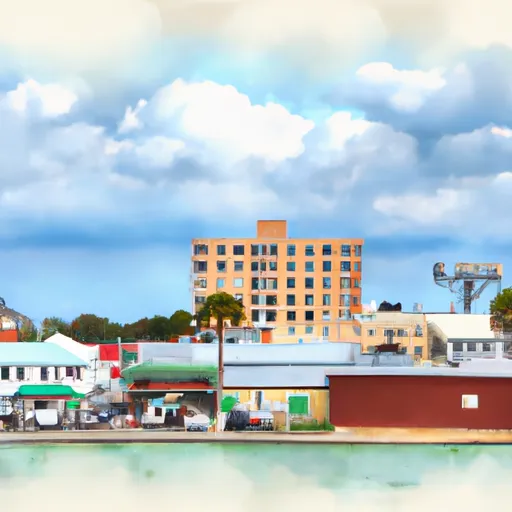-
 Snoflo Premium
Snoflo Premium
Get unlimited access to all our content
With no Ad interruptions! - Start Your Free Trial Login with existing account
Port-Saint-Joe
Eden Index
Climate
7.2
•
Recreation
4.5
•
Community
•
Safeguard
4.5/10

Port Saint Joe is a charming coastal town located in Gulf County, Florida. It enjoys a humid subtropical climate characterized by hot and humid summers and mild, comfortable winters. Summers in Port Saint Joe are typically warm, with temperatures averaging in the low to mid-90s °F (32-35 °C), while winters are mild with temperatures ranging from the mid-40s to low 60s °F (7-16 °C). The area also experiences frequent rainfall throughout the year.
The town is blessed with abundant hydrology constituents, as it is situated on the shores of St. Joseph Bay, an estuary known for its pristine waters and diverse marine life. The bay supports a healthy ecosystem, including seagrass beds, oyster reefs, and mangrove forests. Visitors can engage in various water activities such as swimming, snorkeling, kayaking, and fishing.
Port Saint Joe offers numerous outdoor recreation opportunities. St. Joseph Peninsula State Park, located just south of the town, boasts miles of white sandy beaches, dunes, and coastal habitats. It provides excellent opportunities for camping, hiking, birdwatching, and wildlife viewing. Fishing enthusiasts can explore the bay and nearby Gulf of Mexico for a chance to catch a variety of fish species. Additionally, the area is home to several golf courses, parks, and trails, allowing residents and visitors to enjoy the natural beauty of the region.
What is the Eden Index?
The Snoflo Eden Index serves as a comprehensive rating system for regions, evaluating their desirability through a holistic assessment of climate health, outdoor recreation opportunities, and natural disaster risk, acknowledging the profound impact of these factors on livability and well-being.
Climate Health Indicator (CHI): 7.2
Port-Saint-Joe receives approximately
1526mm of rain per year,
with humidity levels near 87%
and air temperatures averaging around
20°C.
Port-Saint-Joe has a plant hardyness factor of
9, meaning
plants and agriculture in this region tend to thrive here all year round.
By considering the ideal temperature range, reliable water supplies, clean air, and stable seasonal rain or snowpacks, the Climate Health Indicator (CHI) underscores the significance of a healthy climate as the foundation for quality living.
A healthy climate is paramount for ensuring a high quality of life and livability in a region, fostering both physical well-being and environmental harmony. This can be characterized by ideal temperatures, reliable access to water supplies, clean air, and consistent seasonal rain or snowpacks.
Weather Forecast
Streamflow Conditions
Florida Panhandle Coastal
Area Rivers
Florida Panhandle Coastal
Snowpack Depths
Florida Panhandle Coastal
Reservoir Storage Capacity
Florida Panhandle Coastal
Groundwater Levels
Recreational Opportunity Index (ROI): 4.5
The Recreational Opportunity Index (ROI) recognizes the value of outdoor recreational options, such as parks, hiking trails, camping sites, and fishing spots, while acknowledging that climate plays a pivotal role in ensuring the comfort and consistency of these experiences.
Access to outdoor recreational opportunities, encompassing activities such as parks, hiking, camping, and fishing, is crucial for overall well-being, and the climate plays a pivotal role in enabling and enhancing these experiences, ensuring that individuals can engage in nature-based activities comfortably and consistently.
Camping Areas
| Campground | Campsites | Reservations | Toilets | Showers | Elevation |
|---|---|---|---|---|---|
| Florida Caverns State Park | None | 144 ft | |||
| White Oak Creek | None | 237 ft | |||
| Hardridge Creek | None | 215 ft | |||
| Dead Lakes State Rec Area | None | 23 ft | |||
| Falling Waters State Park | None | 267 ft | |||
| St. Joseph Peninsula State Park | None | 7 ft | |||
| Blue Springs State Park | 50 | 306 ft | |||
| Houston County Center | 63 | 326 ft | |||
| LakePoint State Park | 192 | 208 ft |
Nearby Ski Areas
Catastrophe Safeguard Index (CSI):
The Catastrophe Safeguard Index (CSI) recognizes that natural disaster risk, encompassing floods, fires, hurricanes, and tornadoes, can drastically affect safety and the overall appeal of an area.
The level of natural disaster risk in a region significantly affects safety and the overall livability, with climate change amplifying these risks by potentially increasing the frequency and intensity of events like floods, fires, hurricanes, and tornadoes, thereby posing substantial challenges to community resilience and well-being.
Community Resilience Indicator (CRI):
The Community Resilience Indicator (CRI) recognizes that education, healthcare, and socioeconomics are crucial to the well-being of a region. The CRI acknowledges the profound impact of these elements on residents' overall quality of life. By evaluating educational resources, healthcare accessibility, and economic inclusivity, the index captures the essential aspects that contribute to a thriving community, fostering resident satisfaction, equity, and social cohesion.

